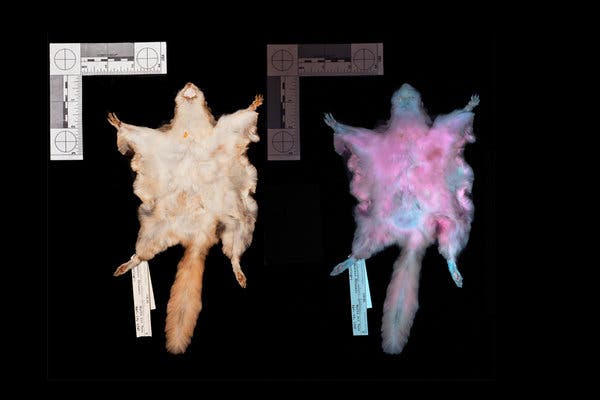Some species of squirrels are all about the nightlife, or so it would seem. The flying squirrels in the area seem to be one such species. They are active when other nocturnal wildlife are out…and apparently, they are dressed for the occasion as well. Its recently been discovered that flying squirrels glow pink under a UV light. This unique trait of these wildlife citizens, as well as their indispensable role in preserving the environment, make the humane approach an important facet of squirrel control in Milwaukee and Wisconsin in general.
The Discovery
North American Flying squirrels have been hiding an exciting secret- they glow pink in the dark under ultraviolet light. The discovery was (accidentally) made by Wisconsin biologist and forestry professor at Northland College in Ashland John Martin and his student assistant as they investigated the presence and behavior of frogs, fungi, plants, and lichens.
Martin was collecting data for a different study he was working on. To collect the requisite data he ventured into the forests of Wisconsin at night armed with a UV flashlight. When he accidentally turned the beam on a flying squirrel he saw, for the first time, an occurrence that was to become the hallmark of groundbreaking scientific research- the squirrel’s body was pink in color!
Squirrel Fluorescing at a Closer Look
In order to confirm his accidental findings, Martin decided to engage an expert in rodent biology, fellow professor Paula Spaeth. Together, they engaged in a broader study. A team led by graduate students in the wildlife and fisheries department of the Texas A&M University conducted the study. They examined numerous squirrel specimen made available through the Science Museum of Minnesota and the Field Museum in Chicago. In conducting the experiment they aimed ultraviolet light at flying and non-flying squirrel species.
The results revealed that most species of flying squirrels (three of which can be found in Milwaukee) have this special pink glow-in-the-dark feature. In fact, while none of the ground or tree squirrels showed fluorescing capabilities, only one of the flying squirrels didn’t show up pink under the special lighting. They also discovered that the gender of the squirrel had no impact on its ability to fluoresce. The findings of the study were published in January 2019 in the Journal of Mammalogy by senior author and biologist at Northland College, Paula Spaeth, and co-author John Martin.
The squirrels aren’t pink all the time though. The color only appears in the dark under ultraviolet lighting. This reflects a biological feature called fluorescing, a feature that few wildlife animals such as some frog species have. Animals with fluoresce abilities are able to absorb light in one color and reflect it in another. Other animals with this trait include puffins, chameleons (whose bones reflect a blue hue under UV lighting), and about two dozen species of opossums.
What This Means for Human-Wildlife Relationships and Interactions
This shockingly exciting discovery also raises more questions about these squirrels. Among these questions is the most immediate “why does this phenomenon take place?” And “what other wildlife species possess this intriguing ability?”
If you thought Wisconsin’s flying squirrels were already special given their ability to glide through the air (an ability they owe to the flap of expandable wing-like skin along their sides) now you have good reason to think they are exceptionally spectacular. It should also encourage you to support the use of humane squirrel control in Milwaukee and other regions.



